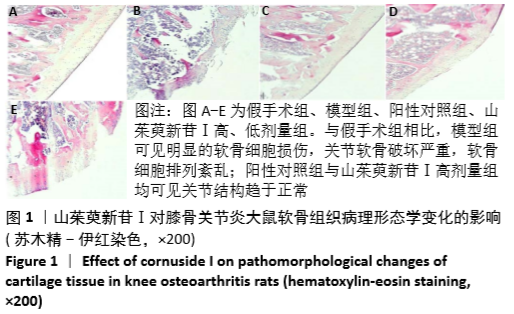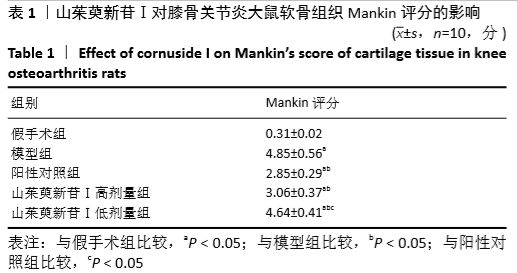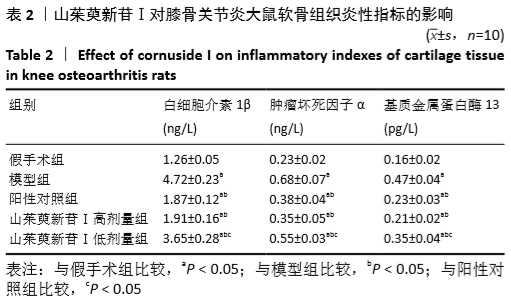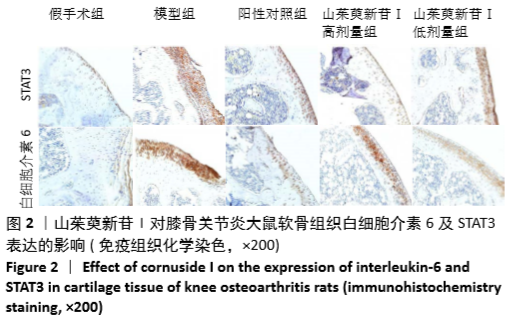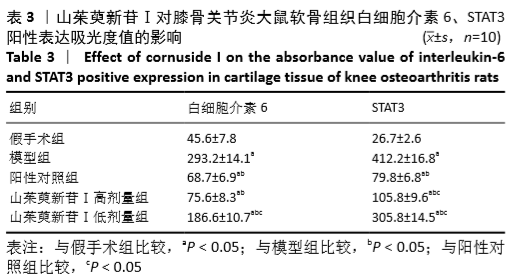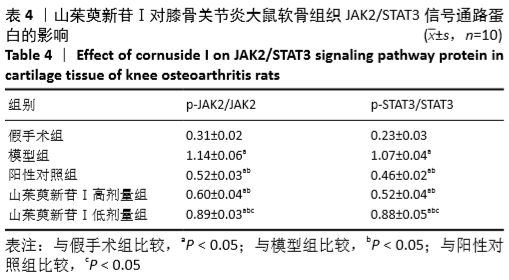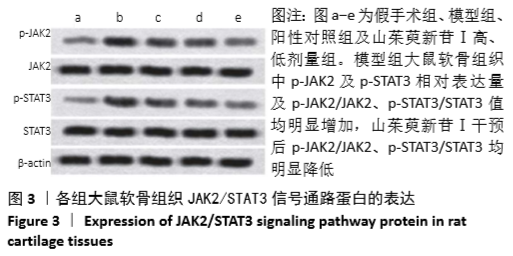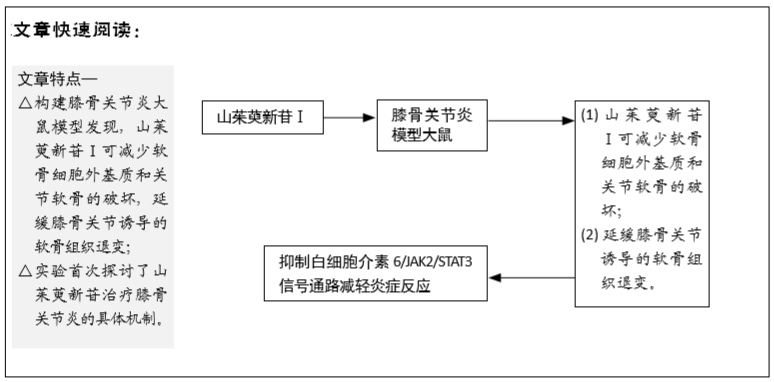中国组织工程研究 ›› 2021, Vol. 25 ›› Issue (2): 211-215.doi: 10.3969/j.issn.2095-4344.2971
• 骨组织构建 bone tissue construction • 上一篇 下一篇
山茱萸新苷Ⅰ干预膝骨关节炎模型大鼠抑制白细胞介素6介导的炎性反应
李虎业1,窦增花1,孔德元1,蔡金莲1,李泽清2
- 1 青海省第四人民医院药剂科,青海省西宁市 810000;2 青海大学附属医院,青海省西宁市 810000
Cornuside I inhibits interleukin-6-mediated inflammation in knee osteoarthritis rats
Li Huye1, Dou Zenghua1, Kong Deyuan1, Cai Jinlian1, Li Zeqing2
- 1Pharmacy Department of the Fourth People’s Hospital of Qinghai Province, Xining 810000, Qinghai Province, China; 2Affiliated Hospital of Qinghai University, Xining 810000, Qinghai Province, China
摘要:

文题释义:
膝骨关节炎:为关节软骨变性、增生引起的慢性退行性骨病,临床主要表现为负重关节疼痛、肿胀或畸形。
山茱萸新苷:为传统配伍中药山茱萸中主要的抗炎、抗氧化成分,同时具有调节骨细胞增殖、降血糖、抗肿瘤和调节免疫等多种药理学活性。
背景:研究表明山茱萸新苷Ⅰ可促进成骨和软骨细胞的增殖,但对于修复膝骨关节炎早期软骨损伤的作用和机制尚不明确。
目的:观察山茱萸新苷Ⅰ对膝骨关节炎模型大鼠的作用及其对白细胞介素6/JAK2/STAT3信号通路的影响。
方法:将SD大鼠随机分为5组,除假手术组外,其他组均参照Hulth法制备膝骨关节炎大鼠模型,建模后山茱萸新苷Ⅰ低、高剂量组分别灌服山茱萸新苷Ⅰ1.25,5 g/kg,每日1次,阳性对照组则灌喂4 mg/kg的塞来昔布,假手术组与模型组则灌喂等量的生理盐水,每日1次,6周后于末次给药24 h后,苏木精-伊红染色观察大鼠关节软骨组织病理形态学变化,并依据Mankin’s法对大鼠软骨组织结构的退变程度进行评分;ELISA检测大鼠软骨组织中白细胞介素1β、肿瘤坏死因子α及基质金属蛋白酶13水平;免疫组织化学染色检测大鼠关节软骨组织中白细胞介素6、STAT3蛋白表达;Western blot法测定大鼠关节软骨组织中JAK2,p-JAK2,STAT3及p-STAT3蛋白相对表达量。
结果与结论:①模型组大鼠关节软骨破坏严重,可见明显的软骨细胞损伤,软骨细胞排列紊乱,山茱萸新苷Ⅰ低、高剂量组与阳性药对照组均可见关节结构趋于正常,软骨细胞分布趋于均匀,裂隙减小;②与模型组比较,山茱萸新苷Ⅰ低、高剂量组软骨组织Mankin评分、白细胞介素1β、肿瘤坏死因子α及基质金属蛋白酶13水平明显降低(P < 0.05),白细胞介素6和STAT3免疫反应均明显降低(P < 0.01),p-JAK2及p-STAT3蛋白相对表达量及p-JAK2/JAK2,p-STAT3/STAT3比值均明显降低(P < 0.05);(3)与阳性对照组相比,山茱萸新苷Ⅰ低剂量组的上述指标均增加(P < 0.05),山茱萸新苷Ⅰ高剂量组无显著差异;③结果证实,山茱萸新苷Ⅰ可延缓骨关节炎诱导的软骨组织退变,其机制可能与降低炎症因子表达,抑制白细胞介素6/JAK2/STAT3信号通路介导的炎症反应有关。
https://orcid.org/0000-0003-4883-3928 (李虎业)
中国组织工程研究杂志出版内容重点:组织构建;骨细胞;软骨细胞;细胞培养;成纤维细胞;血管内皮细胞;骨质疏松;组织工程
中图分类号:
